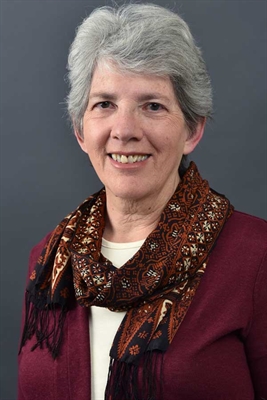ZEN MESTEREK ZEN MASTERS
« Zen főoldal
« vissza a Terebess Online nyitólapjára

Diane Riggs
Dr. Diane Riggs studied sewing Buddha's robe with Zenkei Blanche Hartman, and now teaches in the Department of Comparative Religion at Western Michigan University. She conducted her dissertation research in Kyoto at Ryūkoku University (2002–2007) and the International Research Center for Japanese Studies (Kokusai Nihon bunka kenkyū senta) (2002–2003). Her dissertation, The Cultural and Religious Significance of Japanese Buddhist Vestments, is the first full-length study of Japanese Buddhist robes that integrates textual sources with historical and contemporary material culture. Her research interests include the integration of religious practice with material culture and the agency of women in supporting this culture. Dr. Riggs also studied at the Inter-university Center for Japanese Language Education in Yokohama. She has also taught courses in Indian, Chinese and Japanese religious traditions; Buddhist meditation traditions; and Zen Buddhism.
PDF: The Cultural and Religious Significance of Japanese Buddhist Vestments
Dissertation by Diane Riggs
University of California, Los Angeles, 2010. 334 pages
Buddhist literature attributes the origin of monks' robes to the historical Buddha. The robes are thus imbued with the wisdom of the Buddha. Indian monastic codes distinguished between the ascetic practice of wearing robes made from discarded rags picked up from the road, and the monastic practice of wearing robes made from donated cloth. As Buddhism spread, robes were adapted to different cultures, often with minimal reference to monastic codes. The history of this adaptation in Japan, the subject of this research, is revealed by investigating examples of garments, depictions of robes in Buddhist art, and a rich literary tradition about the spiritual power of the robe. The form of both rag robes and monastic robes changed in East Asia. Robes sewn from colorful pieces of fabric imitated robes made of discarded rags. In Japan, such robes were used in rituals for the preservation of the state, given as gifts to the monarch, and preserved at the treasury of the eighth century monarch, Shōmu and other temples. Portraits of eminent Buddhist teachers depict them wearing these multi-colored robes. The monastic robe also changed as Buddhist clerics at court were required to wear robes in the color of their court rank rather than the subdued colors prescribed by monastic codes. Seventeenth century reformers attempted to reshape Japanese Buddhist robes to fit the prescriptions of ancient monastic codes. The Shingon Buddhist teacher, Jiun Onkō, supplemented this kind of textual study by examining art and ancient robes. He taught his followers to make monastic robes according to the codes, and robes that he identified as "rag robes," using the ancient multi-colored pieced robes preserved in Japan as a model. The monastic and rag robes made by Jiun's followers inspired the twentieth century Sōtō Zen priest, Sawaki Kōdō, to popularize sewing robes. Following the teachings of Dōgen, the founder of Sōtō Zen, Sawaki encouraged lay and ordained men and women to sew and wear their own robes as a return to fundamental Buddhist practice, an approach at odds with the customs of Sōtō Zen. The interdisciplinary approach of this dissertation reveals the dynamic interplay between text, art, and textiles that created a vibrant material culture of Japanese Buddhist vestments.
Publications by Diane E. Riggs
PDF: 福田会 Fukudenkai: Sewing the Buddha's Robe in Contemporary Japanese Buddhist Practice
Japanese Journal of Religious Studies
Vol. 31, No. 2, Traditional Buddhism in Contemporary Japan (2004), pp. 311-356.
(article consists of 46 pages)This paper discusses twentieth-century Buddhist robe study and sewing groups called fukudenkai that were established after World War II by the Sōtō Zen priest and scholar Sawaki Kōdō (1898-1965) and his disciples. The term fukudenkai refers to a metaphor of spiritual efficacy (a field of merit) that the robe embodies, and many participants believe that the act of sewing the robe in a context of meditation and formal Zen practice produces merit. Sawaki's promotion of faith in the Buddhist robe as equivalent to faith in the Buddhist teaching is based on two essays by Dōgen (1200-1253), who is revered as the founder of the Japanese Sōtō Zen lineage. In addition to Sōtō commentaries on Dōgen's essays, Sawaki also made use of the texts and practical robe sewing techniques developed by the pioneering Shingon scholar, Jiun Ōnkō (1718-1804). The form and materials of fukudenkai robes are quite different from the modern forms established by the Sōtō administrative office, whose regulations guide commercial robe makers. Fukudenkai groups thus provide an alternative to the centrally controlled commercial culture of robe making in contemporary Japan.
PDF: “The Buddhist Robe According to the Teaching: Nyohōe, Nōe and Funzōe”.
by Riggs, Diane (2007). Bulletin of Buddhist Cultural Institute, Ryukoku University, 46, pp. 87-97.Table of contents
I. The concept of Nyohoe* (87)
Il. Three Paradigms of the Buddhist Robe (89)
III. Negotiating between the three Paradigms (92)
Conclusion (94)
Notes (95)
Abbreviation(97)
Bibliography(97)*Nyohōe 如法衣, Nōe 納衣/衲衣 and 糞掃衣 Funzōe
PDF: Robes of Rags (糞掃衣 funzōe) and Silk in the Edo Period:
面山瑞方 Menzan Zuihō (1683-1769) and 上田照遍 Ueda Shōhen (1828-1907) Interpret the Practice of the Buddhist Robe
Journal of Indian and Buddhist Studies (Indogaku Bukkyō gaku kenkyū), (March 2007)
Volume 55. Issue 3, pp 1161-1166.Materials appropriate for Buddhist robes: Two Edo period interpreters of the Rag robe (funzōe) and Daoxuan's prohibition of silk robes.
PDF: Interpreting the Material Heritage of the 'Elephant Trunk Robe' in Soto Zen
(2015), pp. 235-259.